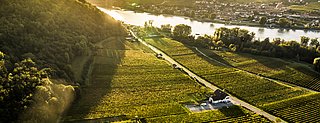
Zanzl
Facts:
- Town:
- Rührsdorf
- Size in ha:
- 7,38
- Altitude in m:
- 207 - 235
- Aspect:
- NW
- Average Slope in %:
- 10
- Max. Slope in %:
- 51
- Insolation in hours per year:
- 2355
- Terraced vineyard:
- No
- Distance to Danube in m:
- 162
- Labour required in h:
- 2.600
- First documentary evidence:
- JF 1786 - 1787
Description
The Zanzl vineyard rounds off the Rossatz and Rührsdorf vineyards to the west. The warmer influence that the east-facing vineyards of this district enjoy can no longer be felt here. These wines have a much cooler but still rich note.
Soil Profile Zanzl
The soils in the upper section of the Zanzl vineyard are dominated by Gföhl gneiss. With rounded edges, the stones and rocks have obviously moved some distance. This profile apparently consists of deposits from glacial solifluction. The freezing temperatures during the last ice age resulted in permafrost soils that thawed only superficially in summer. Alternating freezing and thawing caused frost fissures in the upper layers of rock. Loess deposits covered the rubble and layers above, acting as a sort of lubricant during thaw periods. This resulted in a water-saturated mass that gradually slid during the summer months, from what is now Dunkelsteinerwald to the Danube valley below. The rocks were smoothed in the process. At deeper levels the soil still contains loess, which ensures the vines an ample water supply even in hot summers.






